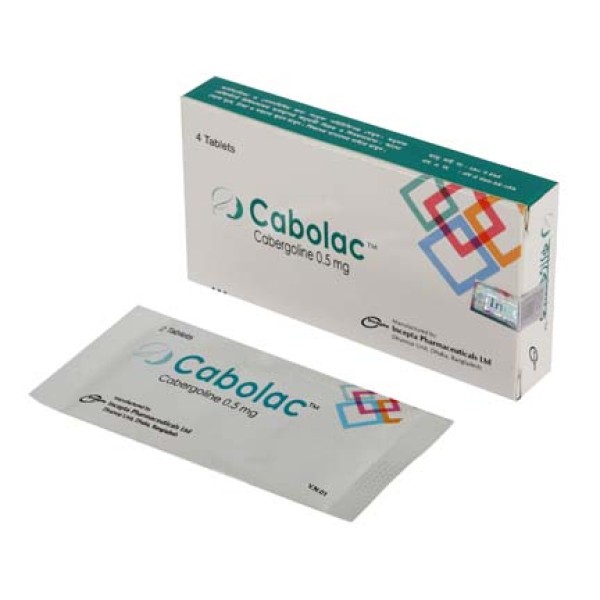
- Stock: In Stock
- Brand: Incepta Pharmaceuticals
- Product ID: Cabergoline
100% Secure Payment

Description
Cabolac Tablet contains Cabergoline, a dopamine receptor agonist. Cabergoline is a dopaminergic ergoline derivative with potent and long-lasting prolactin lowering activity. It acts by direct stimulation of the D2-dopamine receptors on pituitary lactotrophs, thus inhibiting prolactin secretion.
Indications
1. Cabolac is indicated for the inhibition of physiological lactation soon after delivery, stillbirth, abortion or miscarriage.
2. Cabolac is indicated for the treatment of dysfunctions associated with hyperprolactinaemia, including- amenorrhoea, oligomenorrhoea, anovulation and galactorrhoea. Cabolac is indicated in patients with prolactin-secreting pituitary adenomas (micro- and macroprolactinomas), idiopathic hyperprolactinaemia, or empty sella syndrome with associated hyperprolactinaemia, which represent the basic underlying pathologies contributing to the above clinical manifestations.
Dosage & Administration
Cabolac is to be administered by the oral route. It should be preferably taken with meals.
The recommended dosage of Cabolac tablets for initiation of therapy is 0.25 mg twice a week. Dosage may be increased by 0.25 mg twice weekly up to a dosage of 1 mg twice a week according to the patient's serum prolactin level. Dosage increases should not occur more rapidly than every 4 weeks, so that the physician can assess the patient's response to each dosage level. If the patient does not respond adequately and no additional benefit is observed with higher doses, the lowest dose that achieved maximal response should be used and other therapeutic approaches considered. After a normal serum prolactin level has been maintained for 6 months, Cabolac may be discontinued, with periodic monitoring of the serum prolactin level to determine whether or when treatment with Cabolac should be reinstituted.
Inhibition of physiological lactation: Cabolac should be administered during the first day after delivery. The recommended therapeutic dose is 1mg (two 0.5mg tablets) as a single dose.
To stop lactation once have started to breastfeed: 0.25 mg (one half of Cabolac 0.5 mg tablet) every 12 hours for two days.
Treatment of hyperprolactinaemic disorders: The recommended initial dosage of Cabolac is 0.5mg per week given in one or two (½ of a 0.5mg tablet) doses (e.g. on Monday and Thursday) per week. The weekly dose should be increased gradually preferably by adding 0.5mg per week at monthly intervals. The therapeutic dosage is usually 1mg per week and ranges from 0.25 to 2mg per week. Doses of Cabolac up to 4.5mg per week have been used in hyperprolactinaemic patients until the optimal therapeutic response is achieved.
Severe hepatic insufficiency: Lower doses should be considered in patients with severe hepatic insufficiency.
Children: The safety and efficacy of Cabergoline has not been established in subjects less than 16 years of age.
Elderly: Data for use of Cabergoline in elderly is very limited. Available data do not indicate a special risk.
Side Effects
All side effects were mild to moderate in severity and of a transient nature. The most frequently occurring adverse events were dizziness/vertigo, headache, nausea and abdominal pain. In addition rarely palpitations, epigastric pain, somnolence, epistaxis and transient hemianopsia, vomiting, syncope, asthenia, and hot flushes were reported. Cabolac withdrawal results in reversal of side effects, usually within a few days after discontinuation.
Asymptomatic decreases in blood pressure (20mmHg systolic and 10mmHg diastolic) may occur usually once during the first 3-4 days after child birth.
Precautions
Hypersensitive (allergic) to Cabergoline, to other medicines called ergot alkaloids, (e.g. pergolide, bromocriptine, lisuride, ergotamine or ergometrine) or to any of the other ingredients in the tablet.
Severe liver disease and High blood pressure in pregnancy associated with swelling and protein in the urine.
Anti-psychotics or have a history of mental illness associated with child-birth.
Use in Pregnancy & Lactation
Treated with Cabergoline for a long period and have or had fibrotic reactions (scar tissue) affecting your heart.
During pregnancy: Before Cabolac administration, pregnancy should be excluded. Cabolac should be used during pregnancy only if clearly needed. If conception occurs during therapy with Cabolac, discontinuation of treatment should be considered, after careful evaluation of the risks and benefits to mother and foetus.
During lactation: No information is available on the excretion in breast milk in humans; however, mothers should be advised not to breast-feed in case of failed lactation inhibition/suppression by Cabolac. Since it prevents lactation, Cabolac should not be administered to mothers with hyperprolactinaemic disorders who wish to breast-feed their infants.
Drug Interaction
Cabolac should not be administered concurrently with –D2 antagonists, such as Phenothiazines, Butyrophenones, Thioxanthenes, Or Metoclopramide.
Medicines to lower blood pressure. Medicines used to treat mental illness (e.g. antipsychotic medicines like chlorpromazine, haloperidol). Medicines for nausea and vomiting (e.g. domperidone). Medicines for severe migraine headaches (e.g. pergolide bromocriptine, lisuride, ergotamine, dihydroergotamine, ergometrine or methysergide).
Over Dose
There is no experience in humans of overdosage with Cabolac in the proposed indications: it is likely to lead to symptoms due to over-stimulation of dopamine receptors.
These might include nausea, vomiting, gastric complaints, hypotension, nasal congestion, confusion hallucinations, psychosis or thought/perception disturbances. Treatment of overdose is symptomatic and supportive.
In addition, in case of pronounced central nervous system effects the administration of dopamine antagonist drugs may be advisable.
Storage
Store in a cool & dry place, protected from light and moisture.
Keep out of reach of children.






























